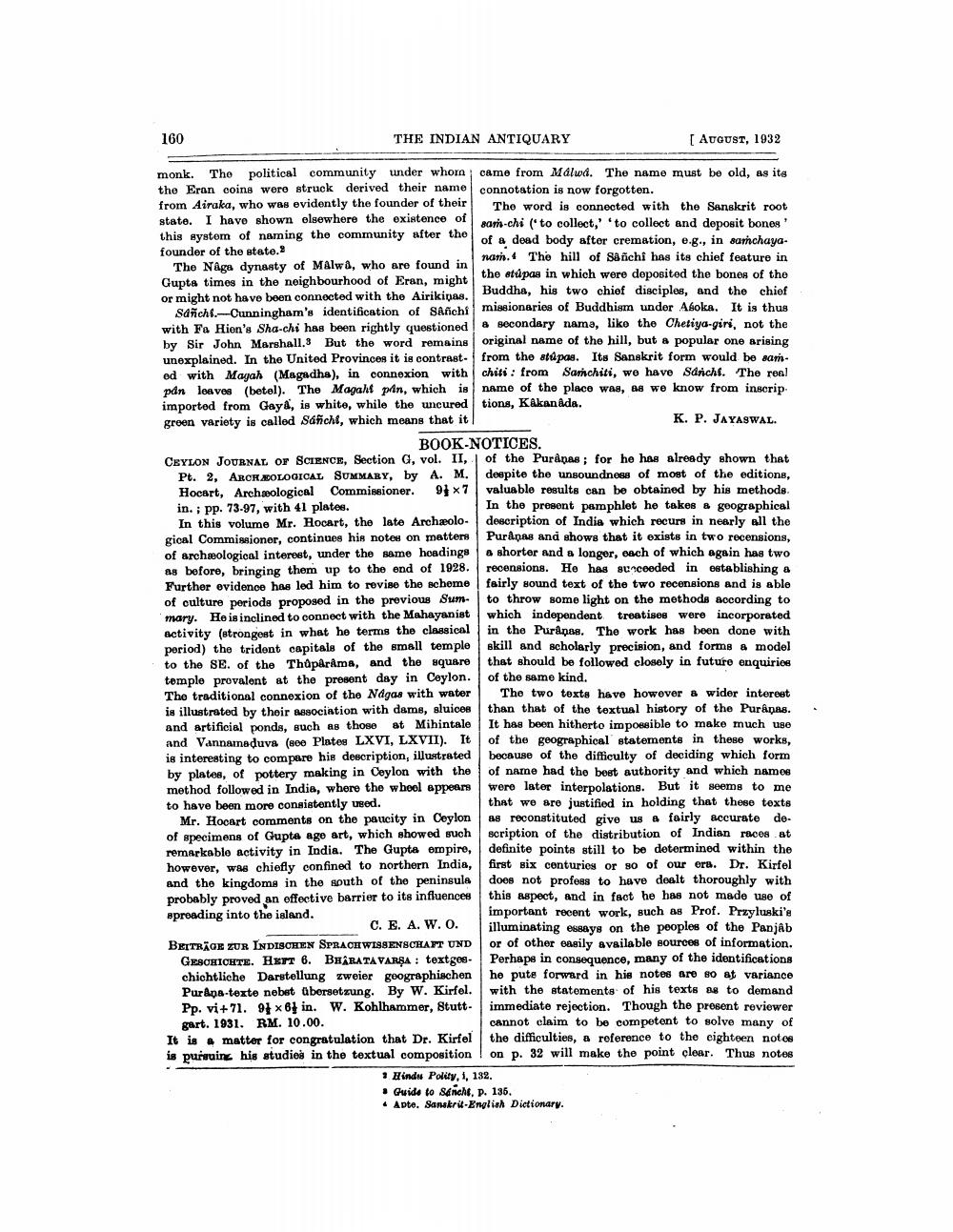________________
160
THE INDIAN ANTIQUARY
[ AUGUST, 1932
monk. The political community under whor came from Málua. The name must be old, as its the Eron coins were struck derived their name connotation is now forgotten. from Airaka, who was evidently the founder of their
The word is connected with the Sanskrit root state. I have shown elsewhere the existence of
sam-chi ("to collect,' 'to collect and deposit bones this system of naming the community after the
of a dead body after cremation, e.g., in sanchayafounder of the state.”
nam. The hill of Sanchi has its chief feature in The Naga dynasty of Malwa, who are found in Gupta times in the neighbourhood of Eran, might
the stupas in which were deposited the bones of the or might not have been connected with the Airikinas.
Buddha, his two chiof disciples, and the chief sañchi.Cunningham's identification of SAfichi missionaries of Buddhism under Aboka. It is thus with Fa Hion's Sha-chi has been rightly questioned ! & secondary nama, like the Chetiya-giri, not the by Sir John Marshall. But the word remains original name of the hill, but a popular one arising unexplained. In the United Provinces it is contrast. from the atdpas. Itu Sanskrit form would be aaned with Mayah (Magadha), in connexion with chiti: from Sarnchiti, wo have Sdnichi. The real pdn loaves (betol). The Magalt piin, which is name of the place was, as we know from inscrip imported from Gayá, is white, while the uncured tions, Kakanada. groen variety is called Safiche, which means that it
K. P. JAYASWAL. BOOK NOTICES. CEYLON JOURNAL OF SCIENCE, Section G, vol. II, of the Puranas; for he has already shown that
Pt. 2, ARCHAEOLOGICAL SUMMARY, by A. M. deepite the unsoundness of most of the editions, Hocart, Archeological Commissioner. 9jx7 valuable results can be obtained by his methods. in.; pp. 73-97, with 41 platee.
In the present pamphlet he takes a geographical In this volume Mr. Hocart, the late Archæolo- description of India which recurs in nearly all the gical Commissioner, continues his notew on matters Puranas and shows that it exists in two recensions, of archeological interest, under the same hoadings a shorter and a longer, each of which again has two as before, bringing them up to the end of 1928. recensions. He has sunceeded in establishing a Further evidence has led him to revise the scheme fairly sound text of the two recensions and is able of culture periode proposed in the previous Sum- to throw some light on the methods according to mary. He is inclined to connect with the Mahayanist which independent treatises were incorporated activity (strongest in what he terms the classical in the Purapas. The work has been done with period) the tridont capitals of the small temple skill and scholarly precision, and forms a model to the SE. of the Thaparáma, and the square that should be followed closely in future enquiries templo provalent at the present day in Ceylon. of the same kind. The traditional connexion of the Nagas with water The two texts have however a wider interest is illustrated by their sesociation with dams, sluices than that of the textual history of the Puranas. and artificial ponda, such as those at Mihintale It has been hitherto impossible to make much use and Vannamaduva (800 Plates LXVI, LXVII). It of the geographical statements in these works, is interesting to compare his description, illustrated because of the difficulty of deciding which form by plates, of pottery making in Ceylon with the of name had the best authority and which names method followed in India, where the whool appears were later interpolations. But it seems to me to have been more consistently used.
that we are justified in holding that these texts Mr. Hocart comments on the paucity in Ceylon as reconstituted give us a fairly accurate deof specimens of Gupta age art, which showed such scription of the distribution of Indian races at remarkable activity in India. The Gupta empire, definite points still to be determined within the however, was chiefly confined to northern India, first six conturios or so of our ori. Dr. Kirfel and the kingdoma in the south of the peninsula does not profess to have dealt thoroughly with probably proved an offective barrier to its influences this aspect, and in fact he has not made use of spreading into the island.
important recent work, such as Prof. Przyluskile C. E. A. W.O.
illuminating essays on the peoples of the Panjâb BEITRÄGE ZUR INDISCHEN SPRACHWISSENSCHAFT UND or of other easily available sources of information.
GROHICHTE. HxIT 6. BHARATAVARAA : textges. Perhaps in consequence, many of the identifications chichtliche Darstellung zweier geographischen he pute forward in his notes are 80 st variance Pur&na-texte nebst übersetzung. By W. Kirfel. with the statements of his texts as to demand Pp. vi+ 71. 91 x 61 in. W. Kohlhammer, Stutt- immediate rejection. Though the present reviewer gart. 1931. RM. 10.00.
cannot claim to be competent to solve many of It is a matter for congratulation that Dr. Kirfel the difficulties, & reference to the eighteen notes is pursuing his studies in the textual composition ! on p. 32 will make the point clear. Thus notes
1 Hindu Polity, 1, 132. • Guide to Sánche, P. 135. • Apte. Sanskrit-English Dictionary.




